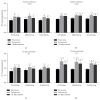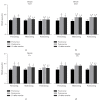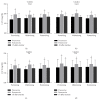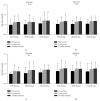Age-related responses in circulating markers of redox status in healthy adolescents and adults during the course of a training macrocycle
- PMID: 25945150
- PMCID: PMC4402481
- DOI: 10.1155/2015/283921
Age-related responses in circulating markers of redox status in healthy adolescents and adults during the course of a training macrocycle
Abstract
Redox status changes during an annual training cycle in young and adult track and field athletes and possible differences between the two age groups were assessed. Forty-six individuals (24 children and 22 adults) were assigned to four groups: trained adolescents, (TAD, N = 13), untrained adolescents (UAD, N = 11), trained adults (TA, N = 12), and untrained adults (UA, N = 10). Aerobic capacity and redox status related variables [total antioxidant capacity (TAC), glutathione (GSH), catalase activity, TBARS, protein carbonyls (PC), uric acid, and bilirubin] were assessed at rest and in response to a time-trial bout before training, at mid- and posttraining. TAC, catalase activity, TBARS, PC, uric acid, and bilirubin increased and GSH declined in all groups in response to acute exercise independent of training status and age. Training improved aerobic capacity, TAC, and GSH at rest and in response to exercise. Age affected basal and exercise-induced responses since adults demonstrated a greater TAC and GSH levels at rest and a greater rise of TBARS, protein carbonyls, and TAC and decline of GSH in response to exercise. Catalase activity, uric acid, and bilirubin responses were comparable among groups. These results suggest that acute exercise, age, and training modulate the antioxidant reserves of the body.
Figures









Similar articles
-
Redox Homeostasis and Inflammation Responses to Training in Adolescent Athletes: a Systematic Review and Meta-analysis.Sports Med Open. 2020 Aug 3;6(1):34. doi: 10.1186/s40798-020-00262-x. Sports Med Open. 2020. PMID: 32748060 Free PMC article. Review.
-
Enhanced erythrocyte antioxidant status following an 8-week aerobic exercise training program in heavy drinkers.Alcohol. 2018 Jun;69:57-62. doi: 10.1016/j.alcohol.2017.11.035. Epub 2017 Dec 2. Alcohol. 2018. PMID: 29653379
-
Sampling time is crucial for measurement of aerobic exercise-induced oxidative stress.Med Sci Sports Exerc. 2007 Jul;39(7):1107-13. doi: 10.1249/01.mss.0b013e318053e7ba. Med Sci Sports Exerc. 2007. PMID: 17596778
-
Α-lipoic acid supplementation up-regulates antioxidant capacity in adults with G6PD deficiency.Food Chem Toxicol. 2013 Nov;61:69-73. doi: 10.1016/j.fct.2013.01.055. Epub 2013 Feb 14. Food Chem Toxicol. 2013. PMID: 23416142 Clinical Trial.
-
Factors influencing post-exercise plasma protein carbonyl concentration.Free Radic Res. 2016;50(4):375-84. doi: 10.3109/10715762.2015.1131824. Epub 2016 Feb 12. Free Radic Res. 2016. PMID: 26873473 Review.
Cited by
-
Effect of exercise intensity on redox biomarkers in healthy adults: A systematic review and meta-analysis of randomized clinical trials.PLoS One. 2025 Aug 20;20(8):e0330185. doi: 10.1371/journal.pone.0330185. eCollection 2025. PLoS One. 2025. PMID: 40834031 Free PMC article.
-
Redox Homeostasis and Inflammation Responses to Training in Adolescent Athletes: a Systematic Review and Meta-analysis.Sports Med Open. 2020 Aug 3;6(1):34. doi: 10.1186/s40798-020-00262-x. Sports Med Open. 2020. PMID: 32748060 Free PMC article. Review.
-
High-intensity functional training modulates oxidative stress and improves physical performance in adolescent male soccer players: a randomized controlled trial.BMC Sports Sci Med Rehabil. 2025 Mar 4;17(1):38. doi: 10.1186/s13102-024-01037-7. BMC Sports Sci Med Rehabil. 2025. PMID: 40038817 Free PMC article.
-
Cutting edge concepts: Does bilirubin enhance exercise performance?Front Sports Act Living. 2023 Jan 11;4:1040687. doi: 10.3389/fspor.2022.1040687. eCollection 2022. Front Sports Act Living. 2023. PMID: 36713945 Free PMC article. Review.
-
Polyphenol Supplementation and Antioxidant Status in Athletes: A Narrative Review.Nutrients. 2022 Dec 29;15(1):158. doi: 10.3390/nu15010158. Nutrients. 2022. PMID: 36615815 Free PMC article. Review.
References
-
- Ji L. L. Exercise-induced modulation of antioxidant defense. Annals of the New York Academy of Sciences. 2002;959:82–92. - PubMed
-
- Pollack M., Leeuwenburgh C. Molecular mechanisms of oxidative stress and aging. In: Sen C., Packer L., editors. Exercise and Oxygen Toxicity. Amsterdam, The Netherlands: Elsevier; 1999.
-
- Michailidis Y., Karagounis L. G., Terzis G., et al. Thiol-based antioxidant supplementation alters human skeletal muscle signaling and attenuates its inflammatory response and recovery after intense eccentric exercise. The American Journal of Clinical Nutrition. 2013;98(1):233–245. doi: 10.3945/ajcn.112.049163. - DOI - PubMed
Publication types
MeSH terms
Substances
LinkOut - more resources
Full Text Sources
Other Literature Sources
Medical

